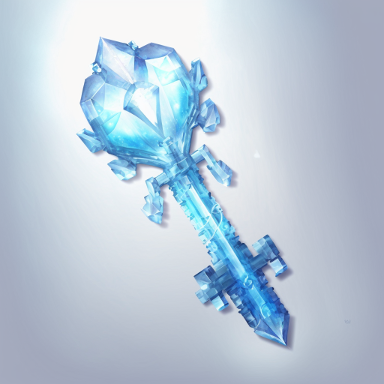Reccosa Waykey
The Reccosa Waykey is made of a semi-transparent blue crystalline material that twinkles in the faintest of light. Shaped like a traditional skeleton key and about 4 inches long, it is not intended to unlock any mechanical lock. It is a Waykey, and with it, access to the Reccosa Microverse is possible.

This waykey was once owned by Thalaman Reccosa, a elven necromancer, until it was acquired by the band of adventurers known as the Ears and Beard Brigade.
Waykey
A Waykey is a magical item that is used to pierce the planar veil revealing an opening to a Microverse. Each key is associated with one specific microverse, although each microverse may have multiple keys.
Typically the key is pressed against a solid surface large enough for a circular aperature of at least five feet across to form. A wall makes a fine surface for this purpose. When the key’s activation word or phrase (its “keyword”) is spoken, a bright light appears at the point of contact. The light begins to spread in a circle revealing the aperture to the associated microverse.
Waykey can take any form, and each is unique.
Microverse
A Microverse, aka, a nook or pocket dimension, is a minor Plane of Existence within the greater multiverse.
Nooks have a finite volume ranging from tiny (a few feet across) to gargantuan (many miles wide) and can be used to securely store anything that fits. The space can be any shape but is often spherical, cubic, or some other Platonic polyhedra. Nooks can be assumed to have gravity that operates perpendicular to the “floor” plane which itself is at a right angle to the aperture.
It is theorized an infinite number of nooks exist, but very few are known.
Access to a microverse and the items stored within is usually gained by using a Waykey which can conveniently open an aperature on any solid surface large enough to support it. The aperture is typically a five foot circle which opens slowly over the span of 1 minute. As it opens, bright, arcing lights flash around its expanding circumfrence accompanied by loud crackling noises of magical energy and often the whistling of air as it rushes through to balance the pressure on both sides.
Physical objects can pass through the opening in either direction while the aperature is open as long as they fit through the opening. The perimeter of an open aperature is clearly framed by scintilating light.
An aperature remains open until closed by speaking the keyword again. Opening a second aperature will cause the first to close. When an aperature closes, it snaps shut instantly. Any item traversing an aperature when it closes will be severed in two, no saving throw.
Microverse apertures can only be opened from the outside. No one knows what happens if a waykey is used from within its associated nook.
While a nook is sealed, no air can enter or escape. The only light in the nook is that which is brought in from outside.
Living creatures within a sealed nook will eventually run out of breathable air unless other provisions are made. This can happen very quickly for tiny nooks. Food, water and waste containment are also problems that need to be addressed for prolonged stays.

